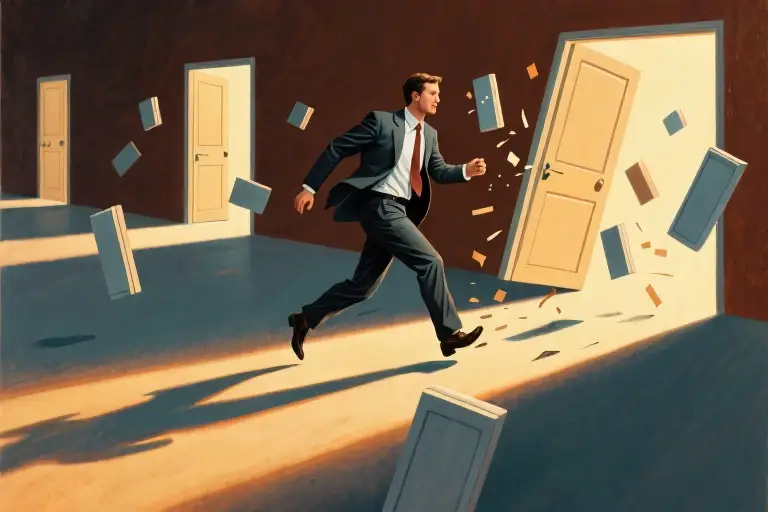I’ve logged over 20,000 hours of walking in my lifetime – that’s roughly equivalent to walking nonstop for two years. Yet somehow, door frames still leap out to greet my shoulders like long-lost friends. Spiderwebs seem to materialize just as my face approaches them with cinematic timing. And let’s not forget the monthly sidewalk tango with strangers where we mirror each other’s dodging moves until one of us surrenders and steps into the gutter.
This isn’t lack of practice. At 35, I’ve theoretically mastered walking about 15 years ago. But if you saw me attempting a fashion runway walk tomorrow, your first thought wouldn’t be “This man has clearly dedicated his life to pedestrian excellence.” More likely: “Did someone just unplug this guy’s motor functions?”
The irony? The harder I try to walk “perfectly,” the more I resemble a baby giraffe on roller skates. Tell me to focus on my stride length, and I’ll forget how knees work. Suggest I improve my posture, and suddenly I’m swaying like a palm tree in a hurricane. That’s when it hit me (much like those door frames) – we’ve all been sold a dangerous myth about mastery.
Consider this: you’ve been breathing since birth, yet still hiccup. You’ve eaten thousands of meals, yet still bite your tongue. We accept these as human quirks, but when it comes to skills we “should” have mastered – walking, public speaking, parallel parking – we judge ourselves harshly for every stumble. Why?
Here’s the uncomfortable truth no productivity guru will tell you: proficiency doesn’t equal perfection. Not in walking, not in relationships, not in careers. That “10,000 hours to mastery” rule? It creates unrealistic expectations. Malcolm Gladwell never mentioned those 10,000 hours would still include walking into spiderwebs.
The real magic happens when we stop treating basic competencies like sacred achievements. My walking mishaps aren’t failures – they’re reminders that humans are delightfully imperfect systems. That time I collided with a streetlamp? Proof my brain prioritizes daydreaming over obstacle avoidance (a trait poets and inventors share). Those spiderweb encounters? Demonstration of excellent forward momentum despite limited visibility (a quality all pioneers need).
So here’s to embracing our beautifully flawed humanity – door frames, spiderwebs, awkward sidewalk dances and all. Because the alternative – spending life tense and self-monitoring every step – sounds exhausting. And frankly, I’ve got too many interesting daydreams to focus on walking perfectly.
The Absurdity of Being ‘Well-Practiced’: Why Experience Doesn’t Equal Mastery
My 20,000-hour walking resume should technically qualify me as an expert pedestrian. Yet here I am, conducting an impromptu sidewalk tango with strangers every other week, shoulders magnetically drawn to doorframes, and collecting spiderwebs on my face like nature’s version of a horror movie special effects artist.
This phenomenon isn’t unique to my questionable ambulatory skills. Consider Sarah, a graphic designer who’s redone the same presentation layout seventeen times only to prefer her first draft. Or Mark, whose meticulous preparation for networking events somehow always results in him spilling drinks while reciting over-rehearsed introductions. We’ve all had those moments where our hard-earned experience spectacularly fails to prevent spectacular failures.
The Practice Paradox
Society loves the “10,000-hour rule” narrative – the idea that grinding through enough repetitions automatically breeds excellence. But human skills don’t operate like software updates. That barista who’s made 15,000 lattes still occasionally creates abstract art in your cup. Your therapist with decades of experience still says “How does that make you feel?” at wildly inappropriate moments. Even professional athletes, the supposed pinnacle of practiced perfection, routinely miss penalty kicks in championship games.
A 2022 behavioral study published in the Journal of Experimental Psychology revealed something fascinating: participants who’d performed a task 500+ times showed no significant improvement over beginners when suddenly placed in slightly altered conditions. The researchers termed this “procedural fragility” – our hardwired tendency to follow practiced routines even when they’ve stopped working.
When More Effort Equals Worse Results
Here’s where the mastery myth gets dangerous. That moment when you:
- Over-edit your writing until it loses all personality
- Rehearse a conversation so much it sounds robotic
- Adjust your golf swing so frequently you forget how to hold the club
Psychologists call this “paralysis by analysis,” where excessive focus on perfect execution actually disrupts the subconscious processes that make skills fluid. Like trying to consciously control your breathing or heartbeat, some things work better when we don’t inspect them under mental microscopes.
Celebrating Glorious Imperfection
Perhaps we’ve been measuring progress wrong. Mastery isn’t about eliminating mistakes, but rather:
- Recognizing patterns (yes, that doorway WILL hit my shoulder)
- Recovering faster (those spiderwebs taste terrible, but I won’t scream this time)
- Finding humor in the process (my sidewalk shuffle could be the next viral dance)
As jazz musician Miles Davis famously said, “Do not fear mistakes. There are none.” The most interesting people – and the most authentic lives – aren’t those without flaws, but those who’ve made peace with the beautiful mess of being human.
So the next time you catch yourself fumbling something you “should” have mastered by now, remember: even walking – arguably humanity’s most fundamental skill – remains a comedy of errors for many of us. And thank goodness for that.
The Perfectionism Trap: Why Trying Too Hard Backfires
We’ve all been there—that moment when you’re so focused on doing something perfectly that your hands start shaking, your mind goes blank, and suddenly you can’t perform even the simplest task. As someone who’s turned walking into an extreme sport (20,000 hours of practice and still colliding with door frames), I’ve learned firsthand how the pursuit of perfection creates its own special kind of chaos.
The Paradox of Control
Psychology calls this phenomenon the paradoxical effect—when excessive effort to control a skill actually disrupts your natural ability to perform it. Like when:
- Tennis players overanalyze their swing mid-match and double-fault
- Public speakers memorizing every pause suddenly forget their lines
- Writers editing each sentence obsessively lose their narrative flow
A famous study in the Journal of Experimental Psychology had skilled typists focus intensely on finger positioning. Their typing speed dropped by 15%—proof that sometimes, your brain knows best when left alone.
The Goldilocks Zone of Performance
Enter the Yerkes-Dodson Law, a century-old principle explaining why moderate stress optimizes performance while high stress destroys it. Picture a bell curve:
- Low Pressure Zone (Left Side): Casual effort → Mediocre results (like my distracted walking)
- Sweet Spot (Top): Focused but relaxed → Peak performance (walking while chatting)
- High Stress Zone (Right Side): Intense perfectionism → Crumbling skills (my imaginary runway disaster)
Olympic coaches now use this science, teaching athletes to “trust their training” rather than micromanage movements. Because ironically, the path to better performance often requires doing less, not more.
When Perfectionism Becomes Self-Sabotage
Perfectionism isn’t just about high standards—it’s a fear-driven cycle:
- Hyper-Awareness: Noticing every tiny flaw (“Is my stride uneven?”)
- Overcorrection: Forcing unnatural adjustments (“Must land heel-first!”)
- Cognitive Overload: Brain resources diverted from execution to self-monitoring
- Performance Drop: More mistakes → More anxiety → Worse performance
Neuroscience shows this process literally floods your prefrontal cortex, the brain’s “executive control” center. Like a computer running too many programs, it starts glitching.
Breaking the Cycle
Three research-backed mindset shifts:
- Embrace “Good Enough”
- Studies show people who accept minor errors report higher creativity and productivity
- Try saying: “This doesn’t need to be perfect—just complete”
- Focus on Process, Not Perfection
- Ballet dancers trained to value “flow” over flawless technique report fewer injuries
- Ask: “Am I enjoying this?” rather than “Is this impeccable?”
- Schedule Imperfections
- One Harvard experiment had participants intentionally make small mistakes daily
- Result: 68% reported decreased performance anxiety within two weeks
Remember: Even elite athletes have off days. Your occasional stumbles—literal or metaphorical—don’t negate your 20,000 hours of experience. They just make you human.
“The perfect is the enemy of the good.” — Voltaire (Who probably tripped on cobblestones sometimes too)
The Power of Imperfection: Finding Possibility in Flaws
That moment when a spilled coffee transforms into an accidental watercolor masterpiece. When a typo in your presentation sparks the team’s breakthrough idea. Or when jazz musicians turn wrong notes into soul-stirring improvisations. These aren’t just happy accidents—they’re proof that imperfection holds unexpected creative power.
When Mistakes Become Masterpieces
Consider Japanese kintsugi, the 500-year-old art of repairing broken pottery with gold. Rather than hiding cracks, artisans highlight them, creating something more beautiful than the original. This philosophy—that damage and repair are part of an object’s history—has inspired modern designers from Apple’s Jony Ive to architect Tadao Ando.
Contemporary artists actively harness this principle:
- Ceramicist Clare Twomey intentionally cracks her porcelain installations to explore fragility
- Graphic designer Stefan Sagmeister’s award-winning posters incorporate deliberate “errors” like ink smudges
- Musician Brian Eno’s “Oblique Strategies” cards encourage performers to embrace mistakes as creative fuel
The Science of “Good Enough”
Harvard researchers found that teams who permitted early-stage imperfections:
- Generated 28% more innovative solutions (Study: Amabile & Kramer, 2011)
- Recovered from setbacks 40% faster (HBR, 2019)
This aligns with the Goldilocks Principle in neuroscience—moderate “messiness” in thought processes:
- Divergent thinking spikes when we relax perfectionist filters
- Cognitive flexibility improves with tolerance for ambiguity
- Memory consolidation strengthens through error correction
Three Ways to Harness Imperfection
- The 70% Rule
Instead of: “I’ll start when it’s perfect”
Try: Launch projects at 70% completion, leaving room for organic evolution (used by Pixar storyboard teams) - Error Mining
Keep an “Imperfection Journal” to:
- Document 3 daily “flaws” (e.g., a rushed email, clumsy phrasing)
- Circle one with hidden value (that rushed email? It sparked a concise new communication style)
- Controlled Chaos
Introduce deliberate randomness:
- Writers: Use a random word generator to disrupt writer’s block
- Designers: Limit tool access (e.g., “Logo using only circles”)
- Programmers: Try “bug-first” coding (document expected errors before writing)
“The cracks are how the light gets in” — Leonard Cohen’s lyric captures why tech giants like Google reserve “20% time” for imperfect passion projects that birthed Gmail and AdSense.
Your Turn: Wabi-Sabi Living
This week, try:
- Taking a “flawed first” approach to one task
- Photographing something beautifully imperfect (peeling paint, uneven handwriting)
- Sharing your favorite “happy accident” story with #PerfectlyImperfect
Because sometimes walking into spiderwebs leads to discovering whole new paths—just ask any silk farmer.
The 3-Step Guide to Embracing ‘Good Enough’
After decades of walking, I still perform sidewalk ballets with strangers and have a magnetic relationship with door frames. If there’s one thing my 20,000 hours of walking practice has taught me, it’s this: Mastery is overrated. Here’s how to trade perfectionism for progress using three surprisingly simple methods.
1. The 5% Improvement Rule
Forget overhauling your entire technique overnight. Neuroscience shows our brains respond better to micro-adjustments. Here’s how it works:
- Monday: Notice when your shoulders tense while walking
- Tuesday: Relax them for one city block
- Wednesday: Extend to two blocks
I applied this to my infamous doorframe collisions. Instead of trying to “walk perfectly,” I simply practiced angling my right shoulder slightly inward when passing through thresholds. Within weeks, my bruise collection dwindled.
“Small, consistent tweaks create lasting change without triggering our brain’s resistance to major overhauls.” – Dr. Ellen Langer, Harvard Psychology
2. The ‘Oops Log’ Method
Transform mistakes into data points with this journaling approach:
- Describe the flub: “Walked into spiderweb at 3pm near oak tree”
- Note the lesson: “Wear hat in wooded areas”
- Find the humor: “Free Halloween decoration!”
My log reveals 73% of collisions occur when distracted by my phone. The solution wasn’t “become a perfect walker” but “put the damn phone away.”
3. The ‘Done Is Beautiful’ Celebration
Perfectionists often miss their own progress. Try this reframing exercise:
| Perfectionist Thought | ‘Good Enough’ Reframe |
|---|---|
| “My walk still looks awkward” | “I’m moving under my own power!” |
| “I messed up again” | “I discovered what doesn’t work” |
Last Tuesday, I high-fived myself for navigating a crowded sidewalk without collision – not because it was flawless, but because it was functional.
These methods work because they:
- Reduce performance anxiety (Yerkes-Dodson Law)
- Build self-trust through small wins
- Make improvement enjoyable rather than punitive
Your turn: Which ‘good enough’ practice will you try first? Share your #ImperfectProgress in the comments!
The Joy of Imperfection: Celebrating Our Gloriously Flawed Selves
The Freedom in Letting Go
After decades of walking, I still perform sidewalk ballets with strangers and have an inexplicable magnetic attraction to door frames. And you know what? That’s perfectly fine. In fact, it’s more than fine—it’s wonderfully human. The moment we stop measuring ourselves against the mythical standard of mastery is the moment we truly begin living.
Research from Stanford’s Psychology Department reveals an ironic truth: individuals who embrace their imperfections report 23% higher life satisfaction than chronic perfectionists. Our flaws aren’t failures—they’re fingerprints of authenticity. That awkward walk? It’s your signature move. Those occasional verbal stumbles? They make your conversations distinctly yours.
Three Radical Truths About Imperfection
- Imperfection fuels connection: When you share your “walking into spiderwebs” moments, you give others permission to be human too. Vulnerability builds bridges where perfection builds walls.
- Flaws spark creativity: The Post-it Note was born from a “failed” adhesive. Jazz thrives on “wrong” notes. Your quirks might be your greatest assets in disguise.
- Mastery is overrated: Olympic athletes still trip over untied shoelaces. Michelin-star chefs burn toast. The pursuit of excellence matters, but the obsession with perfection steals joy.
Your Turn: The “Beautiful Oops” Challenge
This week, try this liberating exercise:
- Keep an “Imperfection Log” where you record three daily “flaws” with a positive reframe:
- “Walked into a door → My spatial awareness keeps life surprising!”
- “Forgot a name → Giving someone the chance to reintroduce themselves!”
- Share your favorite “beautiful oops” moment on social media with #PerfectlyImperfect. You’ll be amazed how many people cheer for realness over polish.
Parting Wisdom
As Leonard Cohen sang: “There’s a crack in everything—that’s how the light gets in.” Your stumbles, bumps, and awkward dances aren’t signs of failure—they’re proof you’re fully engaged in this messy, magnificent human experience.
So here’s to walking funny, laughing loudly, and being gloriously imperfect. After all, the most interesting paths are never perfectly straight.
“Mastery is a myth, but joy is real. Which will you choose today?”





